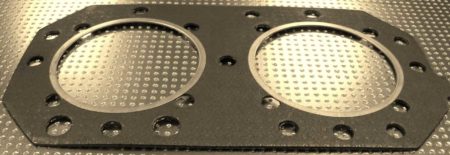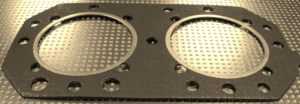 Have you ever been faced with the decision of whether your gaskets are going to need a ring or not? Maybe you’re still in the design stage and are merely asking the question, or you may be experiencing test failures and you’re wondering if a ring is going to be a solution for you. Beyoncé once famously told us, “If you like it, then you should have put a ring on it.” Fortunately, your decision is going to be based on data and not emotion, and it’s also comparatively much less expensive and (hopefully) not a life-changing decision for you.
Have you ever been faced with the decision of whether your gaskets are going to need a ring or not? Maybe you’re still in the design stage and are merely asking the question, or you may be experiencing test failures and you’re wondering if a ring is going to be a solution for you. Beyoncé once famously told us, “If you like it, then you should have put a ring on it.” Fortunately, your decision is going to be based on data and not emotion, and it’s also comparatively much less expensive and (hopefully) not a life-changing decision for you.
Don’t worry…we’re here to help guide you in your decision-making process. Here is a list of reasons why you might find a need to put a flange ring on your gasket.
Why You May Need A Flange Ring
- There is internal pressure (such as combustion pressure) that needs to be contained.
- The gasket material needs to be protected from the internal fluid or pressure or high-temp exposure that might degrade it over time.
- There are loading issues with the bolting such that a metal-to-metal loading will better retain bolt torque values.
- A burn path needs to be avoided. The ring will provide a barrier to this potential for a burn path to work its way through the gasket body to create a leak path.
In case you’re now wondering, here are a few examples of gaskets that use rings: cylinder head gaskets, turbo system exhaust gaskets, high-pressure fluid port gaskets, etc.
It’s Pretty Simple
The data doesn’t lie. If you are seeing (or believe you will see) any of these factors in your design, your best bet is to redesign/design your gasket with a ring. Although it will add cost to your design, it is going to ensure performance – and that is what we all want. Don’t be afraid of added cost up front…think of all the money you’re going to save later when your application doesn’t fail.
If you have any questions about your design and what you might be seeing, please don’t hesitate to ask!
For those of you familiar with Beyoncé’s song “Single Ladies”, we apologize for putting that song into your head the rest of the day. We’ve been singing it to ourselves since we wrote this! If you are interested in subscribing to Sealed-In’s blog posts, email sales@mtigasket.com.

Have you ever been faced with the decision of whether your gaskets are going to need a ring or not? Maybe you’re still in the design stage and are merely asking the question, or you may be experiencing test failures and you’re wondering if a ring is going to be a solution for you. Beyoncé once famously told us, “If you like it, then you should have put a ring on it.” Fortunately, your decision is going to be based on data and not emotion, and it’s also comparatively much less expensive and (hopefully) not a life-changing decision for you.
Don’t worry…we’re here to help guide you in your decision-making process. Here is a list of reasons why you might find a need to put a flange ring on your gasket.
Why You May Need A Flange Ring
- There is internal pressure (such as combustion pressure) that needs to be contained.
- The gasket material needs to be protected from the internal fluid or pressure or high-temp exposure that might degrade it over time.
- There are loading issues with the bolting such that a metal-to-metal loading will better retain bolt torque values.
- A burn path needs to be avoided. The ring will provide a barrier to this potential for a burn path to work its way through the gasket body to create a leak path.
In case you’re now wondering, here are a few examples of gaskets that use rings: cylinder head gaskets, turbo system exhaust gaskets, high-pressure fluid port gaskets, etc.
It’s Pretty Simple
The data doesn’t lie. If you are seeing (or believe you will see) any of these factors in your design, your best bet is to redesign/design your gasket with a ring. Although it will add cost to your design, it is going to ensure performance – and that is what we all want. Don’t be afraid of added cost up front…think of all the money you’re going to save later when your application doesn’t fail.
If you have any questions about your design and what you might be seeing, please don’t hesitate to ask!
For those of you familiar with Beyoncé’s song “Single Ladies”, we apologize for putting that song into your head the rest of the day. We’ve been singing it to ourselves since we wrote this! If you are interested in subscribing to Sealed-In’s blog posts, email sales@mtigasket.com.

Have you ever been faced with the decision of whether your gaskets are going to need a ring or not? Maybe you’re still in the design stage and are merely asking the question, or you may be experiencing test failures and you’re wondering if a ring is going to be a solution for you. Beyoncé once famously told us, “If you like it, then you should have put a ring on it.” Fortunately, your decision is going to be based on data and not emotion, and it’s also comparatively much less expensive and (hopefully) not a life-changing decision for you.
Don’t worry…we’re here to help guide you in your decision-making process. Here is a list of reasons why you might find a need to put a flange ring on your gasket.
Why You May Need A Flange Ring
- There is internal pressure (such as combustion pressure) that needs to be contained.
- The gasket material needs to be protected from the internal fluid or pressure or high-temp exposure that might degrade it over time.
- There are loading issues with the bolting such that a metal-to-metal loading will better retain bolt torque values.
- A burn path needs to be avoided. The ring will provide a barrier to this potential for a burn path to work its way through the gasket body to create a leak path.
In case you’re now wondering, here are a few examples of gaskets that use rings: cylinder head gaskets, turbo system exhaust gaskets, high-pressure fluid port gaskets, etc.
It’s Pretty Simple
The data doesn’t lie. If you are seeing (or believe you will see) any of these factors in your design, your best bet is to redesign/design your gasket with a ring. Although it will add cost to your design, it is going to ensure performance – and that is what we all want. Don’t be afraid of added cost up front…think of all the money you’re going to save later when your application doesn’t fail.
If you have any questions about your design and what you might be seeing, please don’t hesitate to ask!
For those of you familiar with Beyoncé’s song “Single Ladies”, we apologize for putting that song into your head the rest of the day. We’ve been singing it to ourselves since we wrote this! If you are interested in subscribing to Sealed-In’s blog posts, email sales@mtigasket.com.
